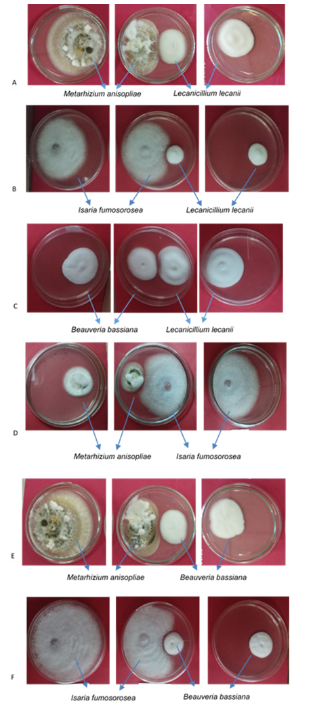In vitro interaction among Cuban strains of four species of entomopathogenic fungi
Main Article Content
Abstract
The objective of the present work was to evaluate the in vitro vegetative compatibility among Cuban strains of the entomopathogenic fungi Lecanicillium lecanii (Zim.) Zare and Gams, Beauveria bassiana (Balsamo) Vuilleming, Isaria fumosorosea (Wise) Brown and Smith, and Metarhizium anisopliae (Mestch) Sorokin, previously selected as biological control agents for harmful insects. Compatibility was evaluated by the Dual Culture method and the percentage of inhibition of radial growth (PIRG) was determined. The type of interaction of microorganisms was classified according to the scale recommended by the literature. In the confrontation tests carried out, no projection of the hyphae of any of the species onto the other species was observed, suggesting an indirect growth inhibition through the excretion of metabolites. In the first seven days, distant mutual inhibition was observed between I. fumosorosea and the rest of the fungi evaluated and the interaction was classified as type C; the PIRG varied between 15.9 - 36.6 %. The growth of B. bassiana also showed inhibition against L. lecanii and M. anisopliae with PIRGof 10.99% and 17.6%, respectively, and the interaction was classified as type E. In the rest of the interactions, no inhibitions were observed. All fungi were compatible so that they can be applied combined with each other in insect pest management.
Article Details

This work is licensed under a Creative Commons Attribution-NonCommercial 4.0 International License.
Aquellos autores/as que tengan publicaciones con esta revista, aceptan los términos siguientes:
- Los autores/as conservarán sus derechos de autor y garantizarán a la revista el derecho de primera publicación de su obra, el cual estará simultáneamente sujeto a la Licencia Creative Commons Attribution-NonCommercial 4.0 International (CC BY-NC 4.0) que permite a terceros compartir la obra, siempre que se indique su autor y la primera publicación en esta revista. Bajo esta licencia el autor será libre de:
- Compartir — copiar y redistribuir el material en cualquier medio o formato
- Adaptar — remezclar, transformar y crear a partir del material
- El licenciador no puede revocar estas libertades mientras cumpla con los términos de la licencia
Bajo las siguientes condiciones:
- Reconocimiento — Debe reconocer adecuadamente la autoría, proporcionar un enlace a la licencia e indicar si se han realizado cambios. Puede hacerlo de cualquier manera razonable, pero no de una manera que sugiera que tiene el apoyo del licenciador o lo recibe por el uso que hace.
- NoComercial — No puede utilizar el material para una finalidad comercial.
- No hay restricciones adicionales — No puede aplicar términos legales o medidas tecnológicas que legalmente restrinjan realizar aquello que la licencia permite.
- Los autores/as podrán adoptar otros acuerdos de licencia no exclusiva de distribución de la versión de la obra publicada (p. ej.: depositarla en un archivo telemático institucional o publicarla en un volumen monográfico) siempre que se indique la publicación inicial en esta revista.
- Se permite y recomienda a los autores/as difundir su obra a través de Internet (p. ej.: en archivos telemáticos institucionales o en su página web) antes y durante el proceso de envío, lo cual puede producir intercambios interesantes y aumentar las citas de la obra publicada. (Véase El efecto del acceso abierto).
References
Pacheco Hernández MDL, Reséndiz Martínez JF, Arriola Padilla VJ. Organismos entomopatógenos como control biológico en los sectores agropecuario y forestal de México: una revisión. RMCF. 2019;10(56). DOI: 10.29298/rmcf.v10i56.496
Mantzoukas S, Eliopoulos PA. Endophytic entomopathogenic fungi: A valuable biological control tool against plant pests. Applied Sciences. 2020;10(1):360. DOI: 10.3390/app10010360
Russo ML. Hongos entomopatogénos: colonización endofítica y control de insectos plaga en cultivos agrícolas [Tesis Doctoral]. Argentina: Universidad Nacional de La Plata; 2017.
Lacey LA, Horton DR, Unruh TR, Pike K, Márquez M. Control biológico de plagas de papas en Norteamérica. In: 2001 Washington State Potato Conference and Trade Show “Taller en Español sobre la producción de papas.” [Internet]. USA: Washington State University; 2001 [cited 2023 Apr 1]. Available from: http://aenews.wsu.edu/May01AENews/SpanishPotato.html
Elizondo AI, Murguido C, Elósegui O, Matienzo Y, Massó E. Nuevas tácticas para el manejo integrado de Thrips palmi Karny en el cultivo de la papa. Fitosanidad. 2008;4(2):102–9.
Ríos R, Vargas-Flores J, Sánchez-Choy J, Oliva-Paredes R, Alarcón-Castillo T, Villegas P. Beauveria bassiana y Metarhizium anisopliae como controladores compatibles y eficientes de insectos plaga en cultivos acuapónicos. Scientia Agropecuaria. 2020;11(3):419–26. DOI: 10.17268/sci.agropecu.2020.03.14
Canfora L, Abu-Samra N, Tartanus M, Łabanowska BH, Benedetti A, Pinzari F, et al. Co-inoculum of Beauveria brongniartii and B. bassiana shows in vitro different metabolic behaviour in comparison to single inoculums. Scientific Reports. 2017;7(1):1–15. DOI: 10.1038/s41598-017-12700-0
Martínez B, Solano T. Antagonismo de Trichoderma spp. frente a Alternaria solani (Ellis & Martin) Jones y Grout. Revista de Protección Vegetal. 1995;10(3):221–5.
Samaniego G, Ulloa S, Herrera S. Hongos del suelo antagonistas de Phymatotrichum omnivorum. Revista Mexicana de Fitopatología [Internet]. 1989;7(1):86–95. Available from: https://biblat.unam.mx/es/revista/revista-mexicana-de-fitopatologia/articulo/hongos-del-suelo-antagonicos-de-phymatotrichum-omnivorum
Magan N, Lacey J. Effect of water activity, temperature and substrate on interactions between field and storage fungi. Transactions of the British Mycological Society. 1984;82(1):83–93. DOI: 10.1016/S0007-1536(84)80214-4
Elósegui O, Elizondo AI. Evaluación microbiológica in vitro de mezclas de especies de hongos entomopatógenos ingredientes activos de bioplaguicidas cubanos. Fitosanidad. 2010;14(2):103–9.
Franco-Chávez KGF, Cruz HM, Mayagoitia JFC, Cruz VHM. Enzimas y toxinas de hongos entomopatógenos, su aplicación potencial como insecticidas y fungicidas. Sociedades Rurales, Producción y Medio Ambiente. 2014;(23):143–60.
Barranco E, Bustamante P, Mayorga-Reyes L, Gonzáles R, Martínez P, Azola A. β-N-acetylglucosaminidase production by Lecanicillium (Verticillium) lecanii ATCC 26854 by solid-state fermentation utilizing shrimp shell. Interciencia. 2009;34(5):356–60.
